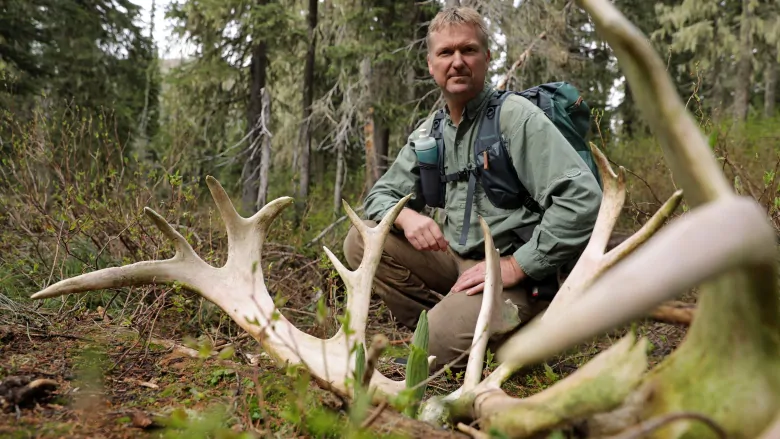7 of 10 herds declared under 'imminent threat' of disappearing are in British Columbia
When Bryce Comer first started trudging through the dense forest of British Columbia's Kootenay Pass in 2008, the Australian knew little about the Canadian wilderness in which he was wandering, let alone the southern mountain caribou he was trying to document.
Trained as a carpenter, he admits he also didn't know much about photography. But armed with a camera and tripod, Comer set out to gather footage so he could enter a nature film contest.
"It was all a huge learning curve," he said.
Comer thought the South Selkirk caribou herd would be the perfect subject matter: After years of being in decline, the 47-animal group that wanders the mountain range in southeastern B.C. was finally growing.
But the conservation success story he hoped to tell went off the rails. Instead of documenting a rebounding herd, his footage captured the last of a dying population.
And then there were 3
"It was like a huge kick in the gut," he said, after finding out earlier this year that the caribou he'd been following for nearly a decade were on the brink of disappearing.
Today, only three animals of the South Selkirk herd remain — all female, and none of them pregnant.
The herd is one of 10 groups that the federal government has declared as being under "imminent threat" of disappearing. Seven of the herds are in B.C., and the rest are all or partly in Alberta. The designation means that if provincial governments in those two provinces don't act, Ottawa can intervene to help protect the herds.
The South Selkirk herd is unique because it is the only one that roams between Canada and the U.S., not to mention that Comer got an up-close look at the population as it rapidly dwindled over the past decade.
It took him months of crossing the mountainous terrain of the Selkirks, sometimes on snowshoes, before he even laid eyes on caribou.
Comer spent days clutching his camera and peering out from his hide, a type of shelter photographers use to try and get as close as possible to animals. He even designed his own high-definition motion-sensor cameras, installing them on trees in areas where the caribou were known to frequent.
But by the time he started capturing the type of footage he needed for his 20-minute film, the growing herd had started to disappear and his focus shifted.
"It changed from being this success story, to trying to show what was actually going on here, and the reasons why."
Changing landscape
The caribou have faced a barrage of change in their habitat — decades of logging and drilling — that leaves them particularly vulnerable to predators, like wolves.
Leo DeGroot, a wildlife biologist with the B.C. government, believes the situation has reached a critical point, as the province's two southernmost populations appear to be about to die off. In addition to the three-animal South Selkirk herd, only four caribou are left in the south Purcells, an adjacent mountainous area.
"The biggest challenge is to recover the caribou — and maintain the economic activities that drive the province," he said.
The caribou depend on large tracts of mature forest to survive.
During the past 15 years, a lot of the core caribou habitat in the southern B.C. has been protected from further logging, DeGroot said. But he admits it's likely too late for the populations already there, because their numbers are so low.
"Hopefully we can turn things around in the other parts of the province," he said.
Maternity pen
Over the years, a number of desperate and expensive steps have taken to try and save the herds in British Columbia. Some caribou have been transplanted to parts of the province to try and boost numbers, while wolves were culled in an attempt to protect those that still remain.
However, biologists admit none of the interventions have proven so far that there is a clear way to regrow the herds once they have been decimated.
But one of the measures that has seen some success lies high on a mountaintop in northern B.C.
A large fence encircles a seven-hectare enclosure that is acting as a maternity ward for the Klinse-Za caribou herd. Pregnant caribou are rounded up each spring and moved into the enclosure, where a veterinarian and "shepherds" are on standby when they calve.
Twelve cows were put in the pen earlier this year, and on Monday, they will be released along with the nine healthy calves that were born this season.
"This is about the future," said Steven Desjarlais, of West Moberly First Nations, one of the two First Nations that launched the initiative back in 2013.
"They were here before any of us. And it's because of us that they might not be here anymore."
Revelstoke pen
Another maternity pen project in Revelstoke, B.C., has seen some success, too, but faced a setback this year when hot temperatures saw some cows struggle during calving.
After a few of the animals died — both cows and calves — the entire group ended up being released early, according to B.C. government officials.
After spending nearly a decade documenting his one herd, Comer produced a film called The Last Mountain Caribou —and he calls the current situation downright depressing.
As a carpenter, Comer said he knows how important forestry is the the province's economy. But he said officials need to get serious about protecting the caribou's habitat.
"What are our children going to say … when they see the caribou on the quarter and there is none left?" he asked. "Why did you let that happen?"

